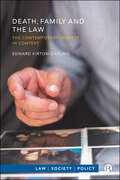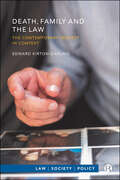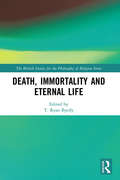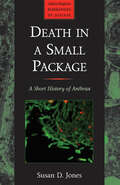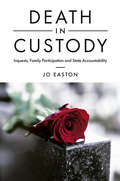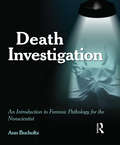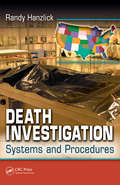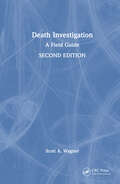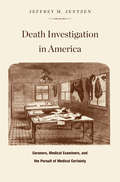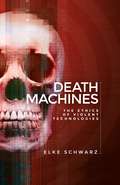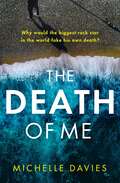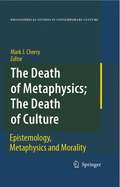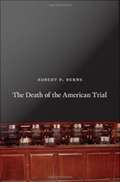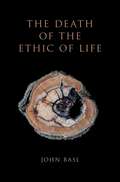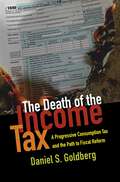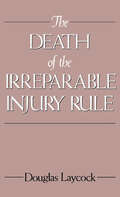- Table View
- List View
Death, Family and the Law: The Contemporary Inquest in Context (Law, Society, Policy)
by Edward Kirton-DarlingWhen a death is investigated by a coroner, what is the place of the family in that process? This accessibly written book draws together empirical, theoretical and historical perspectives to develop a rich, nuanced analysis of the contemporary inquest system in England and Wales. It investigates theories of kinship drawn from socio-legal research and analyses law, accountability and the legal process. Excerpts of conversations with coroners and officers offer real insights into how the role of family can be understood and who family is perceived to be, and how their participation fundamentally shapes the investigation into a death.
Death, Family and the Law: The Contemporary Inquest in Context (Law, Society, Policy)
by Edward Kirton-DarlingWhen a death is investigated by a coroner, what is the place of the family in that process? This accessibly written book draws together empirical, theoretical and historical perspectives to develop a rich, nuanced analysis of the contemporary inquest system in England and Wales. It investigates theories of kinship drawn from socio-legal research and analyses law, accountability and the legal process. Excerpts of conversations with coroners and officers offer real insights into how the role of family can be understood and who family is perceived to be, and how their participation fundamentally shapes the investigation into a death.
Death, Immortality, and Eternal Life (The British Society for the Philosophy of Religion Series)
by T. Ryan ByerlyThis book offers a multifaceted exploration of death and the possibilities for an afterlife. By incorporating a variety of approaches to these subjects, it provides a unique framework for extending and reshaping enduring philosophical debates around human existence up to and after death. Featuring original essays from a diverse group of international scholars, the book is arranged in four main sections. Firstly, it addresses how death is or should be experienced, engaging with topics such as near-death experiences, continuing bonds with the deceased, and attitudes toward dying. Secondly, it looks at surviving death, addressing the metaphysics of human persons, the nature of time, the nature of the true self, and the nature of the divine. It then evaluates the value of mortality and immortality, drawing upon the resources of the history of philosophy, meta-analysis of contemporary debates, and the analogy between individual death and species extinction. Finally, it explores what an eternal life might be like, examining the place of selflessness, embodiment, and racial identity in such a life. This volume allows for a variety of philosophical and theological perspectives to be brought to bear on the end of life and what might be beyond. As such, it will be a fascinating resource for scholars in the philosophy of religion, theology, and death studies.
Death, Immortality, and Eternal Life (The British Society for the Philosophy of Religion Series)
by T. Ryan ByerlyThis book offers a multifaceted exploration of death and the possibilities for an afterlife. By incorporating a variety of approaches to these subjects, it provides a unique framework for extending and reshaping enduring philosophical debates around human existence up to and after death. Featuring original essays from a diverse group of international scholars, the book is arranged in four main sections. Firstly, it addresses how death is or should be experienced, engaging with topics such as near-death experiences, continuing bonds with the deceased, and attitudes toward dying. Secondly, it looks at surviving death, addressing the metaphysics of human persons, the nature of time, the nature of the true self, and the nature of the divine. It then evaluates the value of mortality and immortality, drawing upon the resources of the history of philosophy, meta-analysis of contemporary debates, and the analogy between individual death and species extinction. Finally, it explores what an eternal life might be like, examining the place of selflessness, embodiment, and racial identity in such a life. This volume allows for a variety of philosophical and theological perspectives to be brought to bear on the end of life and what might be beyond. As such, it will be a fascinating resource for scholars in the philosophy of religion, theology, and death studies.
Death in a Small Package: A Short History of Anthrax (Johns Hopkins Biographies of Disease)
by Susan D. JonesA disease of soil, animals, and people, anthrax has threatened lives for at least two thousand years. Farmers have long recognized its lasting virulence, but in our time, anthrax has been associated with terrorism and warfare. What accounts for this frightening transformation? Death in a Small Package recounts how this ubiquitous agricultural disease came to be one of the deadliest and most feared biological weapons in the world.Bacillus anthracis is lethal. Animals killed by the disease are buried deep underground, where anthrax spores remain viable for decades or even centuries and, if accidentally disturbed, can cause new infections. But anthrax can be deliberately aerosolized and used to kill—as it was in the United States in 2001. Historian and veterinarian Susan D. Jones recounts the life story of anthrax through the biology of the bacillus; the political, economic, geographic, and scientific factors that affect anthrax prevalance; and the cultural beliefs about the disease that have shaped human responses to it. She explains how Bacillus anthracis became domesticated, discusses what researchers have learned from numerous outbreaks, and analyzes how the bacillus came to be weaponized and what this development means for the modern world.Jones compellingly narrates the biography of this frightfully hardy disease from the ancient world through the present day.
Death in Custody: Inquests, Family Participation and State Accountability
by Dr Jo EastonDeath in Custody considers the participation of bereaved families in an inquest following a death in custody. It looks at the legal frameworks governing participation, as well as relevant theories of justice, participation, procedural fairness and grief theory. Interviews were carried out with people with personal experience of complex inquests, including bereaved family members. Participation can provide families with redress and allow them to represent the deceased, as well as being an important part of their grief process. It also helps to ensure a fair process, which has a positive impact on accountability and legitimacy. Family participation improves accountability by maximising the chance of achieving the right outcome via scrutiny, therefore identifying failures. Families also brings balance to the process, provide vital information about the deceased as well as helping to ensure that lessons are learned that will prevent future deaths. Death in Custody shows that procedural justice theory is relevant for participation in processes investigating human rights violations. It includes key recommendations on how to ensure participation can be fair and effective.
Death in Custody: Inquests, Family Participation and State Accountability
by Dr Jo EastonDeath in Custody considers the participation of bereaved families in an inquest following a death in custody. It looks at the legal frameworks governing participation, as well as relevant theories of justice, participation, procedural fairness and grief theory. Interviews were carried out with people with personal experience of complex inquests, including bereaved family members. Participation can provide families with redress and allow them to represent the deceased, as well as being an important part of their grief process. It also helps to ensure a fair process, which has a positive impact on accountability and legitimacy. Family participation improves accountability by maximising the chance of achieving the right outcome via scrutiny, therefore identifying failures. Families also brings balance to the process, provide vital information about the deceased as well as helping to ensure that lessons are learned that will prevent future deaths. Death in Custody shows that procedural justice theory is relevant for participation in processes investigating human rights violations. It includes key recommendations on how to ensure participation can be fair and effective.
Death Investigation: An Introduction to Forensic Pathology for the Nonscientist
by Ann BucholtzDeath Investigation: An Introduction to Forensic Pathology for the Nonscientist provides students and law enforcement professionals with an accurate, clear overview of forensic pathology. It presents death investigation at the scene and autopsy, providing readers with a broad understanding of forensic pathology and giving them a clear picture of what happens after the examination of the scene. Readers learn what first responders should (and should not) do at the scene, and get a forensic pathologist's perspective on the importance of preserving evidence. Death Investigation methodically explains what happens during autopsy to determine cause and manner of death — including particulars of blunt force trauma, sharp force injuries, asphyxia, and gunshot wounds — and how findings are presented in court. Written for a criminal justice audience by a practicing forensic pathologist and educator, Death Investigation makes challenging forensics concepts accessible to nonscientists.
Death Investigation: An Introduction to Forensic Pathology for the Nonscientist
by Ann BucholtzDeath Investigation: An Introduction to Forensic Pathology for the Nonscientist provides students and law enforcement professionals with an accurate, clear overview of forensic pathology. It presents death investigation at the scene and autopsy, providing readers with a broad understanding of forensic pathology and giving them a clear picture of what happens after the examination of the scene. Readers learn what first responders should (and should not) do at the scene, and get a forensic pathologist's perspective on the importance of preserving evidence. Death Investigation methodically explains what happens during autopsy to determine cause and manner of death — including particulars of blunt force trauma, sharp force injuries, asphyxia, and gunshot wounds — and how findings are presented in court. Written for a criminal justice audience by a practicing forensic pathologist and educator, Death Investigation makes challenging forensics concepts accessible to nonscientists.
Death Investigation: Systems and Procedures
by Randy Hanzlick M.D.Death Investigation: Systems and Procedures is the first book dedicated to the topic of death investigation from a legal standpoint as well as the administrative and operational procedures that pertain to the medical examiner and the coroner system in the United States. Unique in its perspective, this book is the only one not concerned with instruc
Death Investigation: A Field Guide
by Scott A. WagnerDeath Investigation: A Field Guide, Second Edition is updated and expanded to include a chronological analysis of the death scene investigative process from the first notification to the autopsy and final report. This book is written for the standpoints of a forensic pathologist and a forensic toxicologist emphasizing essential elements of the death investigation and how the results impact the final cause and manner of death. Topics discussed include how to assess the body at the scene and how to properly investigate natural and unnatural deaths. The book discusses various means and causes of deaths, demonstrating how death manifests in various parts of the body. A section on traumatic injuries examines and illustrates with color photographs blunt force, sharp force, gunshot wounds, and a host of other injuries that the investigator is likely to confront. Natural death conditions and disease are discussed in a separate chapter devoted to the most common manner of death. The Second Edition is fully updated with new added sections which cover forensic toxicology, statutory responsibilities, documentation and photography of the scene, DNA identification and possible contamination issues, decomposition, managing and utilizing electronic medical records, anaphylaxis and allergic reactions, infectious diseases such as Covid-19, acute peritonitis, and more. Despite including over 200 full-color photos, the book retains a succinct, handy format that is invaluable to those facing, and tasked with investigating, the reality of death on a day-to-day basis. Death Investigation: A Field Guide, Second Edition continues to serve as an invaluable resource for crime scene investigators (CSIs), coroners, medical death investigators (MDIs), and medical examiner professionals.
Death Investigation: A Field Guide
by Scott A. WagnerDeath Investigation: A Field Guide, Second Edition is updated and expanded to include a chronological analysis of the death scene investigative process from the first notification to the autopsy and final report. This book is written for the standpoints of a forensic pathologist and a forensic toxicologist emphasizing essential elements of the death investigation and how the results impact the final cause and manner of death. Topics discussed include how to assess the body at the scene and how to properly investigate natural and unnatural deaths. The book discusses various means and causes of deaths, demonstrating how death manifests in various parts of the body. A section on traumatic injuries examines and illustrates with color photographs blunt force, sharp force, gunshot wounds, and a host of other injuries that the investigator is likely to confront. Natural death conditions and disease are discussed in a separate chapter devoted to the most common manner of death. The Second Edition is fully updated with new added sections which cover forensic toxicology, statutory responsibilities, documentation and photography of the scene, DNA identification and possible contamination issues, decomposition, managing and utilizing electronic medical records, anaphylaxis and allergic reactions, infectious diseases such as Covid-19, acute peritonitis, and more. Despite including over 200 full-color photos, the book retains a succinct, handy format that is invaluable to those facing, and tasked with investigating, the reality of death on a day-to-day basis. Death Investigation: A Field Guide, Second Edition continues to serve as an invaluable resource for crime scene investigators (CSIs), coroners, medical death investigators (MDIs), and medical examiner professionals.
Death Investigation in America: Coroners, Medical Examiners, and the Pursuit of Medical Certainty
by Jeffrey M. JentzenA death occurs at home, in a hospital, on a street: why? As Jeffrey Jentzen reveals, we often never know. Why is the American system of death investigation so inconsistent and inadequate? What can the events of the assassination of President Kennedy, killing of Bobby Kennedy, and Chappaquiddick reveal about the state of death investigation? If communities in early America had a coroner at all, he was politically appointed and poorly trained. As medicine became more sophisticated and the medical profession more confident, physicians struggled to establish a professionalized, physician-led system of death investigation. The conflict between them and the coroners, as well as politicians and law enforcement agencies, led to the patchwork of local laws and practices that persist to this day. In this unique political and cultural history, Jentzen draws on archives, interviews, and his own career as a medical examiner to look at the way that a long-standing professional and political rivalry controls public medical knowledge and public health.
Death machines: The ethics of violent technologies
by Elke SchwarzAs innovations in military technologies race toward ever-greater levels of automation and autonomy, debates over the ethics of violent technologies tread water. Death Machines reframes these debates, arguing that the way we conceive of the ethics of contemporary warfare is itself imbued with a set of bio-technological rationalities that work as limits. The task for critical thought must therefore be to unpack, engage, and challenge these limits. Drawing on the work of Hannah Arendt, the book offers a close reading of the technology-biopolitics-complex that informs and produces contemporary subjectivities, highlighting the perilous implications this has for how we think about the ethics of political violence, both now and in the future.
Death machines: The ethics of violent technologies
by Elke SchwarzDeath Machines offers a critical reconsideration of ethical theories and political justifications for technologised practices of violence in contemporary conflicts.
The Death of Me
by Michelle Davies'A twisting tale about the dark undercurrents of fame and fortune. You'll read THE DEATH OF ME with your heart in your mouth.' Erin Kelly Is one of music's greatest mysteries about to be solved?'He was a massive star until he did a headline grabbing retreat from the spotlight - but his disappearing act was FAKED. Fans won't be happy when they find out - his reputation was dead in the water.'When Isaac Naylor committed suicide after a teenage fan was found dead in his hotel room, the world thought it had lost one of the greatest rock stars of a generation. Naylor, lead singer of The Ospreys, had been arrested for causing the girl's death and was on police bail when he drowned himself in the sea off the Devon coast.Now, eight years on, music journalist Natalie Glass stumbles across a blind item on a US gossip website that suggests Naylor's death wasn't quite what it seemed - and he might in fact still be alive.But as she delves deeper into what happened, Natalie finds she has a stark choice: give up trying to find out what happened to Naylor or risk her own obituary ending up in print.
The Death of Metaphysics; The Death of Culture: Epistemology, Metaphysics, and Morality (Philosophical Studies in Contemporary Culture #12)
by Mark J. CherryThe Latin root of the English word culture ties together both worship and the tilling of the soil. In both interpretations the outcome is the same: a rightly-directed culture produces either a bountiful harvest or falls short of the mark, materially or spiritually. This volume offers a critical examination of the nature and depth of our contemporary cultural crisis, focused on its lack of traditional orientation and moral understanding.
The Death of the American Trial
by Robert P. BurnsIn The Death of the American Trial, distinguished legal scholar Robert P. Burns makes an impassioned case for reversing the rapid decline of the trial before we lose one of our public culture’s greatest achievements. As a practice that is adapted for modern times yet rooted in ancient wisdom, the trial is uniquely suited to balance the tensions—between idealism and realism, experts and citizens, contextual judgment and reliance on rules—that define American culture. Arguing that many observers make a grave mistake by taking a complacent or even positive view of the trial’s demise, Burns concludes by laying out the catastrophic consequences of losing an institution that so perfectly embodies democratic governance.
The Death of the American Trial
by Robert P. BurnsIn The Death of the American Trial, distinguished legal scholar Robert P. Burns makes an impassioned case for reversing the rapid decline of the trial before we lose one of our public culture’s greatest achievements. As a practice that is adapted for modern times yet rooted in ancient wisdom, the trial is uniquely suited to balance the tensions—between idealism and realism, experts and citizens, contextual judgment and reliance on rules—that define American culture. Arguing that many observers make a grave mistake by taking a complacent or even positive view of the trial’s demise, Burns concludes by laying out the catastrophic consequences of losing an institution that so perfectly embodies democratic governance.
The Death of the American Trial
by Robert P. BurnsIn The Death of the American Trial, distinguished legal scholar Robert P. Burns makes an impassioned case for reversing the rapid decline of the trial before we lose one of our public culture’s greatest achievements. As a practice that is adapted for modern times yet rooted in ancient wisdom, the trial is uniquely suited to balance the tensions—between idealism and realism, experts and citizens, contextual judgment and reliance on rules—that define American culture. Arguing that many observers make a grave mistake by taking a complacent or even positive view of the trial’s demise, Burns concludes by laying out the catastrophic consequences of losing an institution that so perfectly embodies democratic governance.
The Death of the Ethic of Life
by John BaslMany subscribe to an Ethic of Life, an ethical perspective on which all living things deserve some level of moral concern. Within philosophy, the Ethic of Life has been clarified, developed, and rigorously defended; yet it has also found its harshest critics. Between biocentrists, those that endorse the Ethic of Life, and those that accept a more restricted view of moral status, the debate has reached a standstill, with few new resources for shifting or complicating it. In The Death of the Ethic of Life, John Basl seeks to end this comfortable stalemate by emphasizing a simple truth: the well-being of non-sentient beings, such as plants, species, and ecosystems, is morally significant only to the extent that it matters to sentient beings. Basl first develops a version of The Ethic of Life that best meets traditional challenges: the Ethic, if it is to survive criticism, must be able to explain how it is that all living things have a welfare or a good of their own. The best hope of offering such an explanation is to ground that welfare in teleology or goal-directedness, and then to ground that goal-directedness in the workings of natural selection. While a naturalistic account of teleology is crucial to defending an Ethic of Life, it is also its downfall. This Ethic ultimately entails that not only are ecosystems and collectives morally considerable, but so, too, are artifacts: everything from can openers to computers. Basl shows that evaluation of the resources for distinguishing artifacts from organisms forces us to abandon, for good, the Ethic of Life. The Death of the Ethic of Life provides not only a new answer to a fundamental question in environmental ethics, but a new way to conceive of fundamental concepts and issues in debates over who or what matters from the moral point of view, with wide-ranging implications in the philosophy of technology and bioethics.
The Death of the Ethic of Life
by John BaslMany subscribe to an Ethic of Life, an ethical perspective on which all living things deserve some level of moral concern. Within philosophy, the Ethic of Life has been clarified, developed, and rigorously defended; yet it has also found its harshest critics. Between biocentrists, those that endorse the Ethic of Life, and those that accept a more restricted view of moral status, the debate has reached a standstill, with few new resources for shifting or complicating it. In The Death of the Ethic of Life, John Basl seeks to end this comfortable stalemate by emphasizing a simple truth: the well-being of non-sentient beings, such as plants, species, and ecosystems, is morally significant only to the extent that it matters to sentient beings. Basl first develops a version of The Ethic of Life that best meets traditional challenges: the Ethic, if it is to survive criticism, must be able to explain how it is that all living things have a welfare or a good of their own. The best hope of offering such an explanation is to ground that welfare in teleology or goal-directedness, and then to ground that goal-directedness in the workings of natural selection. While a naturalistic account of teleology is crucial to defending an Ethic of Life, it is also its downfall. This Ethic ultimately entails that not only are ecosystems and collectives morally considerable, but so, too, are artifacts: everything from can openers to computers. Basl shows that evaluation of the resources for distinguishing artifacts from organisms forces us to abandon, for good, the Ethic of Life. The Death of the Ethic of Life provides not only a new answer to a fundamental question in environmental ethics, but a new way to conceive of fundamental concepts and issues in debates over who or what matters from the moral point of view, with wide-ranging implications in the philosophy of technology and bioethics.
The Death of the Income Tax: A Progressive Consumption Tax and the Path to Fiscal Reform
by Daniel S. GoldbergThe Death of the Income Tax explains how the current income tax is needlessly complex, contains perverse incentives against saving and investment, fails to use modern technology to ease compliance and collection burdens, and is subject to micromanaging and mismanaging by Congress. Daniel Goldberg proposes that the solution to the problems of the current income tax is completely replacing it with a progressive consumption tax collected electronically at the point of sale.
The Death of the Income Tax: A Progressive Consumption Tax and the Path to Fiscal Reform
by Daniel S. GoldbergThe Death of the Income Tax explains how the current income tax is needlessly complex, contains perverse incentives against saving and investment, fails to use modern technology to ease compliance and collection burdens, and is subject to micromanaging and mismanaging by Congress. Daniel Goldberg proposes that the solution to the problems of the current income tax is completely replacing it with a progressive consumption tax collected electronically at the point of sale.
The Death of the Irreparable Injury Rule
by Douglas LaycockThe irreparable injury rule says that courts will not grant an equitable remedy to prevent harm if it would be adequate to let the harm happen and grant the legal remedy of money damages. After surveying more than 1400 cases, Laycock concludes that this ancient rule is dead--that it almost never affects the results of cases. When a court denies equitable relief, its real reasons are derived from the interests of defendants or the legal system, and not from the adequacy of the plaintiff's legal remedy. Laycock seeks to complete the assimilation of equity, showing that the law-equity distinction survives only as a proxy for other, more functional distinctions. Analyzing the real rules for choosing remedies in terms of these functional distinctions, he clarifies the entire law of remedies, from grand theory down to the practical details of specific cases. He shows that there is no positive law support for the most important applications of the legal-economic theory of efficient breach of contract. Included are extensive notes and a detailed table of cases arranged by jurisdiction.
